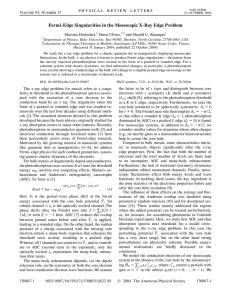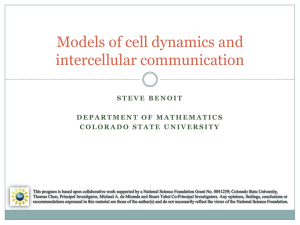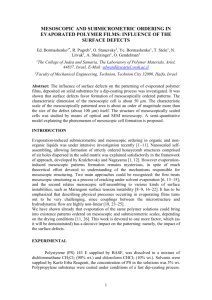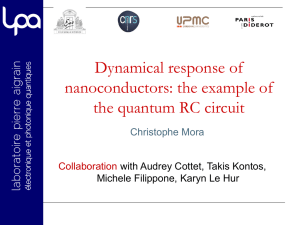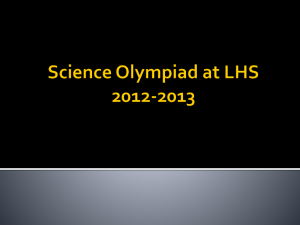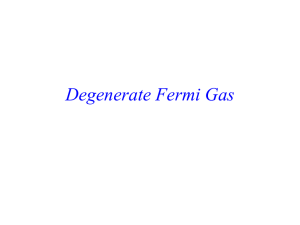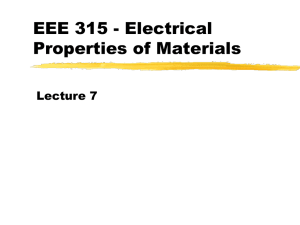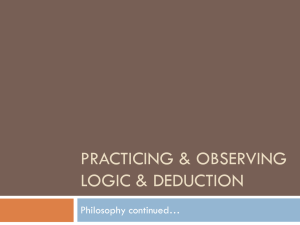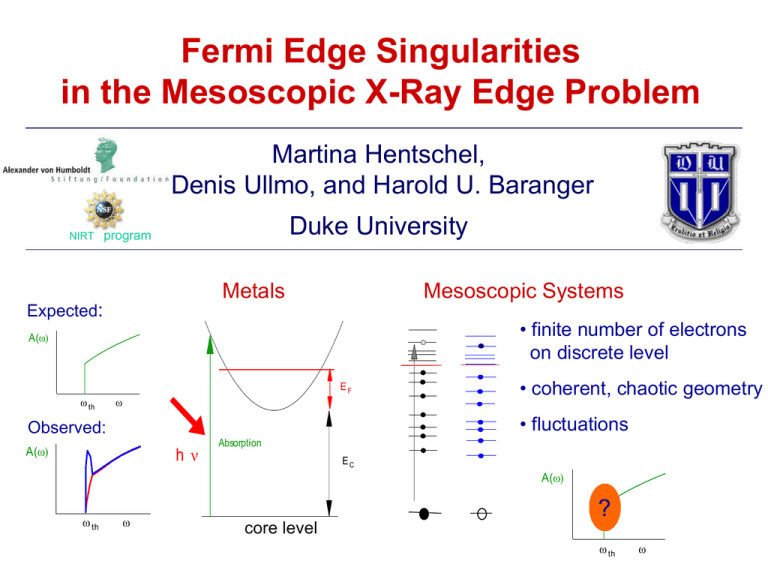
Fermi Edge Singularities
in the Mesoscopic X-Ray Edge Problem
Martina Hentschel,
Denis Ullmo, and Harold U. Baranger
NIRT
Duke University
program
Metals
Mesoscopic Systems
Expected:
• finite number of electrons
on discrete level
A(
• coherent, chaotic geometry
EF
th
• fluctuations
Observed:
h
A(
th
Absorption
EC
{}
{}
A(
?
core level
bare
th
Martina
Hentschel:
The ‘classical’ X-Ray Edge Problem
Yu und Cardona
Fund.of SC,
p.477
Singularities at the Fermi edge threshold in
X-Ray Emission or Absorption Spectra of, e.g., metals
e.g. Peaked Edge
A(
I(
L2,3-edge
simple metals like Al, Mg, (Na)
from K. Othaka, Y. Tanabe, RMP 62 2929 (1990):
GaAs-AlxGa1-xAs Quantum well, Lee et al. (1987)
What happens when a core electron is excited?
~1023 cond. electrons respond
Kondo Problem
+
1 of 1023 electrons
Many-body ground state |F>
made of single particle wf. |ji>
although <yi | ji> ~ 1:
<Y|F> 0 (as N
Sudden perturbation
V
Anderson Orthogonality Catastrophe
Anderson Orthogonality Catastrophe (AOC)
P. W. Anderson, Phys. Rev. Lett. 18 1049 (1967)
ground state
under perturbation V
Perturbation can
be small there
is NO
ADIABATICITY in
those systems!
Y F
~ N
~0
ground state
initially
Or any state
entirely described
in terms of plane
waves
Orthogonality Block
Important in:
•
Fermi edge singularities of x-ray and photoluminescence spectra
•
Kondo physics
•
Tunneling (e.g. in double quantum dots)
CHECK zero-bias
anomaly (in
•
Similar phenomenon in particle physics
dosordered
systems)
Peaked or rounded edge ?
Mesoscopic effects
Many-body effect
“Mahan’s enhancement”
Orthogonality block
due to AOC
finite N
finite N
Competition
screening
dipole selection rules
chaotic geometry
acts universal
relative strength ?
Sample-to-sample fluctuations
Peaked or rounded edge ?
A ( ) ( th )
P hotoabsor ption
2
wit h
lo
l
counteracting
(Mahan) manybody process
(lo only)
where
Citrin, PRB (1979)
Tanabe and Othaka (1990)
2 ( 2 l 1) l
2
Anderson
orthogonality
catastrophe
(all l )
l
.... phase shift for ang. mom. l , t aken at Fermi energy E F
lo
.... optically excited channel l 0
Friedel' s sum rule : Z
l
2 ( 2 l 1) l
Outline of talk
I.
Introduction
II.
Mesoscopic Anderson Orthogonality Catastrophe
• Model, numerical method, results
III.
X-Ray Photoabsorption Spectra: Mesoscopic vs. Bulk-like
• Fermi golden rule approach, role of dipole matrix elements
IV.
Conclusion, Experimental Realizations
II. Anderson Orthogonality Catastrophe
in Mesoscopic Systems
AOC for a rank-1 perturbation V
Tanabe and Othaka, RMP (1990)
Aleiner and Matveev, PRL (1998)
unpert urbe d : Hˆ
perturbed :
{ k , k }
...
F
Hˆ Vˆ { , y } ...
Y
e.g. core hole left behind at r0
N V r0
r0
overlap between perturbed and unperturbed ground states:
2
Y F
2
M
i0
filled
N
j M 1
empty
( j i )( j i )
( j i )( j i )
= f (eigenvalues only)
Example for a rank-1 perturbation
• unperturbed level k: equidistant (“picket fence”, “bulk-like”)
• perturbed level :
Schrödinger equation
1
:
k
50
1
V
k
d
6 level,
attractive
25
pertubation
V
Martina
y
~
Hentschel:
0
0
1
V big
V small
Check this – der
ist gar nicht
constant!!!
-25
0
-50
-4
-2
phase shift
0
1
2
(N ) : b
d
4
6
8
( k k ) arctan
V
d
Rank-1 perturbation in the mesoscopic case
Fluctuations: k, k(ro)
::
| k ( ro ) |
k
• Assumptions:
{k}
{|k(r0)|2}
k
2
1
N V
GOE / GUE distribution
Porter-Thomas distribution
Motivation:
Random matrix theory
chaotic systems: quantum dots, nanoparticles
• Joint probability distribution
P ({ i }, { i })
i>j
(Aleiner/Matveev, PRL 1998)
( i j )( i j )
i, j
i j
N : i = const. = V-1
1 / 2
exp
2
(i i )
i
i
1 ( for GOE (GUE)
Boundary effects
50
d
y
25
0
0
1
1
V big
-25
0
-50
•
-4
-2
run-away level
0
2
6
N d
0
e
•
4
d /V
1
“pressure” from far away level
level-dependent potential and phase shift
N i
ln
i
V
d i
1
1
1
8
Workhorse: Metropolis algorithm on the circle
M of N level filled
•
Start: picket fence
(N+1 level , N+1 level , mean
level spacing d/N, shift b)
•
Random number in (0, 2N+1)
level i or i shifted within interval
given by neighboring levels
Every third step: move pair (i, i)
Memory lost after ~ N steps
d
i+2
i+2
i+1
i i+1
Circle:
constant DOS
i
i-1
i-1
N N
0
0
•
•
•
Metropolis step: accept / reject
change with PM=min(1,
P({i},{i}
generate many ensembles [{k},{k} || ]
distribution of overlaps ||
Results:
1. Ground state overlap distribution P(||)
Onset of AOC
a) as perturbation V ~ vc increases
b) as particle number N increases
25
5
N=1000
v c /d = -0.1
4
N=50
v c /d = -10
2
|Vc|
10
N=250
N=100
P ( | | )
2
P ( || )
v c /d = -1
15
N
N=500
v c /d = -0.25
20
5
3
N=10
2
1
0
0.2
0.4
0.6
overlap ||
0.8
0
1
0
2
0.2
0.4
0.6
overlap ||
2
b
N
| b |
2
2
1
b
2
e
0.8
2
2
bulk values
1
1. P(||) cont.
Scaling and role of phase shift F at Fermi energy
5
| b |
F /
2
2
P(| | )
4
GOE: N , M ,
v c /d
250, 78, -1
3
100, 50, -5
2
100, 31, -1
1
1 0 0 , 1 4 , - 0 .5
0
50, 16, -1
0
0.2
0.4
||
0.6
0.8
1
1.2
0.8
2
P(| | )
1
1
0.6
0.4
GU E
0.5
0.2
0
0
0
1
2
|| / | b |
2
2
3
0
1
2
P(|| determined by phase shift F at Fermi energy
(as in metallic x-ray edge problem)
3
Results:
2. Origin of Fluctuations in P(||)
Reminder :
|
Reference |b - evaluate |
starting at the Fermi edge EF :
( r 1)
2
|
( M 1 M )
( M 1 M )
d
d b
range 1
N
i0
filled
j M 1
empty
( j i )( j i )
2
M+1
EF
M
M+2
M+1
M
M-1
filled
i
bulk case
{}
( j i )( j i )
bulk case
M+1
M
b
M
range 2
bulk case
empty
j
2
bulk case
{}
M
EF
2. Fluctuations in P(||) cont.
GOE
GUE
6
6
v c /d = -0.25
4
2
P (| | )
2
P (| | )
v c /d = -0.25
2
0
0
0.2
0.4
0.6
0.8
4
2
0
1
6
0
2
P (| | )
2
P (| | )
2
0
0.2
0.4
0.6
0.8
1
0.4
0.6
0.8
1
2
0
0.2
6
v c /d = -10
v c /d = -10
4
2
P (| | )
2
0.8
4
0
1
6
P (| | )
0.6
v c /d = -1
4
2
0
0.4
6
v c /d = -1
0
0.2
0
0.2
0.4
0.6
2
overlap ||
0.8
1
N=100, M=50
overlap ||
4
2
range 1
range 2
2
0
anal. range 1
0
0.2
0.4
0.6
2
overlap ||
0.8
1
2. Fluctuations in P(||) cont.
6
v c /d = -0.25
2
analytically understanding
of overlap fluctuations:
P (| | )
GUE
•
consider two level i = 0,1 around EF
in the mean field of other level
4
2
0
0.2
0.4
0.6
0.8
1
0.4
0.6
0.8
1
6
v c /d = -1
2
s = (10) Wigner surmise
|u0|2 , |u1|2 Porter-Thomas
i 2: i , |ui|2, i one random
variable
P (| | )
•
•
•
0
deviation of range-n result from P(||):
4
2
0
0
0.2
6
v c /d = -10
-10
0
10
20
30
range n
2
-0.25
P (| | )
0.1
D KS
v c /d
RMT
justified !
N=100, M=50
overlap ||
4
2
range 1
range 2
2
0
anal. range 1
0
0.2
0.4
0.6
2
overlap ||
0.8
1
Summary part II
AOC in mesoscopic systems
bulk-like
mesoscopic chaotic
• {} equidistant
{},{} fix
• {},{} fluctuating
(GOE/GUE)
• single value || |b|
• RMT treatment justified
|
• bulk: N , |b 0
• broad distribution P(||)
• fluctuations dominated by
levels around EF
• analytic treatment of
range-1 approximation
AOC in disordered systems: Gefen et al. PRB 2002
AOC in parametric random matrices: Vallejos et al. PRB 2002
III. Mesoscopic X-ray Edge Problem
Approaching the Mesoscopic X-Ray Edge Problem
Fermi edge singularities in x-ray spectra of metals
A(
Absorption
EF
h
___
Absorption
I(
Emission
EC
{}
cor
e
bare
Misses many-body effects of core hole potential
on cond. e- : AOC and Mahan’s enhancement
Emission
bare
A(
A(
I(
I(
•
diagrammatic perturbation theory (Mahan, Nozieres,…)
•
Fermi golden rule approach (Tanabe/Othaka)
Model: Fermi golden rule approach
A ( ) 2
Y F Wˆ F c
2
(
EY EF
F
C
F
Tanabe and Othaka, RMP 1990
Dipole
matrix
Y F Wˆ F c
element
unperturbe d : c k k
( k 1,..., N )
( 1,..., N )
~ ~
~
Y 0 c M c M 1 ... c 0 0
N
Wˆ
c cc 0
~
c y
dipole operator :
core elect ron : c c c
perturbed :
F 0 c M c M 1 ... c 0 0
k 1
w kc [ c k c c h.c. ]
Model: Fermi golden rule approach
A ( ) 2
Y F Wˆ F c
2
(
EY EF
F
C
F
g
j
EF
F
M
m
i
0
{}
{}
h
___
core o
direct process
~ |wjc|2 ||
replacement
shake-up
~Sm |wmc|2 |mg|
repl.
direct
Dipole matrix element wjc
w jc c
y j
r x ray
E
~(ro
y j nonloc
bulk-like
e
ik j r
il
J l (k r ) e
w jc φ c u
jc = s-like:
jc = p-like:
mesosc. jc = s-like:
jc = p-like:
k j ',| k j '| | k j |
l orbital channel, partial wave decomp.
bulk-like
s-like
mesoscopic
l
V= (r-r0) l=0:
s-like cond. el.
u
(r )
nk j
~J0’(ro) = 0
=0
a
kj'
e
ik j 'r
l not conserved in chaotic systems
φc u
=0
~J0(ro) 0
wjc =0 at K-edge rounded
wjc 0 at L-edge peaked
wjo ~ ’(r0) ~ yj` peaked or rounded K-edge (yj`, yj indep.)
wjo ~ (r0) ~ yj stronger correlations at L-edge
0
5
10
15
20
0
Results:300
0
0
50
0
vc10
= -10 d, 15
K-edge 20
N = 100, M = 50, GOE
5
200
0
{}
150
V = 10
A ()
1
A ()
10
A ()
A ()
a) Contributions
from the various processes
100
(
5
V= 1
1. Average
Photoabsorption K-edge 100
200
1.5
10
150
V= 1
2
5
100
V = 10 2
~|w
jc|
100
shake-up
bare
0.5
50
0
0
0
1 0
0
j
2
53
4
10 5
( (
) / d /
th
615
7
20 8
0
5
(
M
T
total (direct+repl.+shake up)
i
naiv e bare (norm.)
direct+repl.
10
T /
direct
shake up
0
• peaked edge
• replacement processes near EF dominate
• one-pair shake-up processes dominate
{}
{}
~|wjc|2
||
direct process
replacement
direct + replacement
Results:
1. Average Photoabsorption K-edge
EF
b) Taking spin into account
2
vc = -10 d, K-edge
N = 100, M = 50, GOE
(
1.5
active
1
full spin
0.5
a ctive sp in
0
0
1
2
3
4
(
5
th )
6
7
8
/d
EF
spectator
width of |F0
in basis of perturbed
final states |YF
spectator spin
Comparison with bulk-like case
L-edge bulk-like
(
3
1
K-edge mesoscopic
0.3
0.1
vc = -10 d, GOE
K-edge bulk-like
0
1
2
3
4
(
5
th )
6
7
8
/d
Rounded edge goes into a (slightly) peaked
edge as the system becomes coherent
M.H., D.Ullmo, H.U. Baranger, cond-mat/0402207, subm. to PRL
Dependence on the number of electrons
2
N : Anderson wins
Mesoscopic
K-edge
(
1.5
bare
N=24, M=12
N=50, M=25
1
N=100, M=50
N=200, M=100
0.5
0
0
1
2
3
4
5
6
( th ) / d
7
8
9
10
10
Bulk-like
L-edge
(
7.5
N : Mahan wins
5
2.5
0
0
1
2
3
4
5
6
( th ) / d
7
8
9
10
Results:
2. Average Photoabsorption L-edge
Coupling to the wave function: wjo~ yj
50
y
25
bound state 0:
0
0
1
1
• y0 (r0) piles up
• screens core hole
• s-like
V big
-25
0
-50
EF
-4
-2
0
2
4
6
||
0
8
vc= - 0.1d
vc= -10 d
1
0.03
i=0
0.025
0.8
i=1
2
0.015
i=M=N/2 (E
F)
i=N
0.4
0.01
100 random plane waves,
N=100, M=50
0.2
0.005
0
-10
0.6
|y i |
|y i |
2
i=2
0.02
-5
0
x
5
10
0
-10
-5
0
x
5
10
Average Photoabsorption L-edge cont.
40
vc = -10 d, GOE, active spin
Mesoscopic
L-edge
< A ()>
30
20
10
0
0
1
2
3
4
5
6
< th >/d
7
8
9
10
40
N=100, M=50
< A ()>
Bulk-like
L-edge
• small differences
N=50, M=25
30
mesoscopic vs. bulk-like,
20
and GOE vs. GUE
10
• edge peak with N
0
0
1
2
3
4
5
6
< th >/d
7
8
9
10
Results:
GOE, N=40, M=20, V
3. Mesoscopic fluctuations
in=-10A() = f ( ||2, repl ,shup ; wjc)
c
GOE, N=40, M=20,
g1V
P(A( ) / <A( )>)
K-edge
2
c =-10
K-edge
g
g1
g
g
g
g
g0N
1.5
g
P.Th.
g0N
1
P.Th.
0.5
0
0
1
2
GOE, N=40, M=20, V
3
4
A() / <A()>
GOE, N=40, M=20,
g1V
P(A( ) / <A( )>)
L-edge
2
L-edge
g
g
g
g0N
g
P.Th.
g0N
1
P.Th.
0.5
0
0
1
2
A() / <A()>
3
c =-10
c =-10
g
g1
g
1.5
wjc ~ y’ large Porter-Thomas
like fluctuations
overwhelm overlap
correlations and
dominate fluctuations of A()
4
wjc ~ y narrowly distributed
Symmetry:
replacement through bound
state acts like a ground state
overlap with F’ = F ,
results in highly peaked edge
Experimental Realizations
“Fermi sea of electrons subject to a rank-1 perturbation”
• x-ray photoabsorption with metallic nanoparticles: feasible in few years
• double quantum dots: constriction
Abanin/Levitov, cond-mat/0405383
• photoabsorption via impurity states in semiconductor heterostructures
Quantum Dot Array (diam.~100 nm)
etched from heterostructure
2DEG and
impurities
GaAs
Control Experiment “bulk-like”: no dots, just 2DEG with impurities - already done?
Summary part III
Mesoscopic X-ray Edge Problem
s-like conduction
electrons: 0= /, 1= 0
bulk-like
mesoscopic
• rounded K-edge
• (slightly) peaked K-edge
Average A(
• peaked L-edge
• peaked L-edge
Dipole coupling changed because mesoscopic system is
- chaotic (loose l as quantum number)
- coherent confinement
- wave function and derivative independent
Mesoscopic fluctuations
• individual spectra can even zig-zag
IV.
1.2
AOC in Mesoscopic Systems:
- broad distribution P(||
- scaling with |b|, F
2
2
P (| | /| b | )
•
Conclusions
1
0.8
0.6
0.4
0.2
0
0
1
2
|| / | b |
- K-edge: A( from rounded to
peaked as system becomes coherent,
Porter-Thomas fluctuations
- L-edge: strongly peaked,
same fluctuations as ||
3
3
1
0.3
0.1
•
2
Mesoscopic Photoabsorption Spectra and X-Ray Edge Problem:
(
•
2
Experimental realizations:
- array of quantum dots, impurity
level takes role of core electron
- nanoparticles, double dots
0
1
2
3
4
(
5
th )
6
7
8
/d
M. Hentschel, D. Ullmo, H.U. Baranger,
cond-mat/0402207

